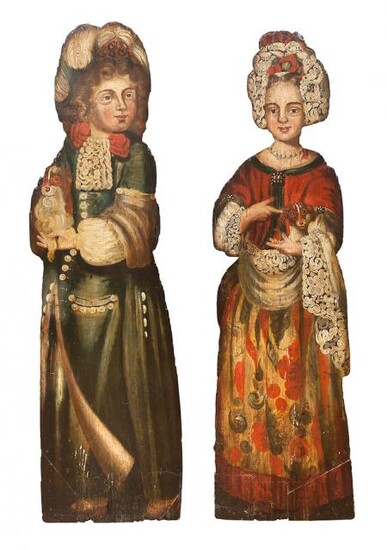Pair of Anglo-Dutch Polychrome-Painted Dummy Boards
Pair of Anglo-Dutch Polychrome-Painted Dummy Boards
First quarter of the 18th century
Each figure depicted with a spaniel; bearing accession nos. 1947-561, 2; bearing a partial printed label...COREA ST. SALE/...18TH & 19TH FEBRUARY/...PLYMOUTH. Height 39 inches (99.0 cm).
Dummy boards, whose origins were in the Low Countries, were popular in England in the 17th and 18th centuries. They are often thought to have been used as fire-screens, but the heat from a fire would have damaged both the wood and the paint. Rather, these trompe l'oeil figures were fanciful objects meant to deceive. C. Graham, Dummy Boards and Chimney Boards, Aylesbury, 1988, p. 3, writes 'Arnold Houbraken, in 1719, describes how the artist Cornelius Bisschop painted cut-out wooden templates which could be placed in a corner or doorway in the hope of deceiving the unwary. One gentleman, for instance, placed a wooden maidservant at the door of his salon and the assembled company were much entertained by a guest who tried to tip her.' The boards were either hooked to the wall or put at a short distance from a wall, creating a shadow when light was cast on them; see also Macquoid and Edwards, The Dictionary of English Furniture, London, 1983, rev. ed., vol II, pp. 229-232, figs. 1-11, for a further discussion.
C The Noel and Harriette Levine Collection
View it on
Sale price
Estimate
Time
Auction House
Pair of Anglo-Dutch Polychrome-Painted Dummy Boards
First quarter of the 18th century
Each figure depicted with a spaniel; bearing accession nos. 1947-561, 2; bearing a partial printed label...COREA ST. SALE/...18TH & 19TH FEBRUARY/...PLYMOUTH. Height 39 inches (99.0 cm).
Dummy boards, whose origins were in the Low Countries, were popular in England in the 17th and 18th centuries. They are often thought to have been used as fire-screens, but the heat from a fire would have damaged both the wood and the paint. Rather, these trompe l'oeil figures were fanciful objects meant to deceive. C. Graham, Dummy Boards and Chimney Boards, Aylesbury, 1988, p. 3, writes 'Arnold Houbraken, in 1719, describes how the artist Cornelius Bisschop painted cut-out wooden templates which could be placed in a corner or doorway in the hope of deceiving the unwary. One gentleman, for instance, placed a wooden maidservant at the door of his salon and the assembled company were much entertained by a guest who tried to tip her.' The boards were either hooked to the wall or put at a short distance from a wall, creating a shadow when light was cast on them; see also Macquoid and Edwards, The Dictionary of English Furniture, London, 1983, rev. ed., vol II, pp. 229-232, figs. 1-11, for a further discussion.
C The Noel and Harriette Levine Collection



